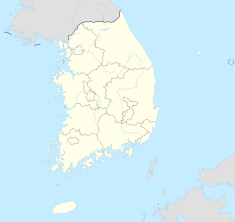Naganeupseong
| Naganeupseong Folk Village | |
|---|---|
| Native name Korean: 낙안읍성 | |
 | |
| Location | Nagan-myeon, Suncheon, South Jeolla, South Korea |
| Coordinates | 34°54′25″N 127°20′20″E / 34.90694°N 127.33889°ECoordinates: 34°54′25″N 127°20′20″E / 34.90694°N 127.33889°E |
| Area | 223,108㎡ |
| Built | 1397 |
 Location of Naganeupseong Folk Village in South Korea | |
| Korean name | |
| Hangul | |
| Hanja | |
| Revised Romanization | Nakaneubseong |
| McCune–Reischauer | Nakanŭpsŏng |
Naganeupseong Folk Village (Korean: 낙안읍성; Hanja: 樂安邑城) is a Korean historic village located in Nagan-myeon, Suncheon, South Jeolla, South Korea.[1] This well-preserved walled town served as an administrative core for the county during the Joseon Dynasty and it is designated as historical site N0. 302.[2]
Overview[]
Naganeupseong is a former administrative town and consist of three neighborhoods located inside the fortress walls, on a level fiel surrounded by mountains. It has preserved traditional elements such as a fortress, government buildings and a cluster of private houses. The hanok style houses are distinguished from other historic villages because of their straw roofs, clay rooms and Korean-style verandas.[3][4] This difference is rooted in the fact that the town of Nagan was mainly inhabited by common people and not aristocrats.
Nowadays there are still around 100 households living in the village, many of them farmers that still carry out the traditional values and arts of the region.
History[]
The fortress was constructed in 1397 during King Taejo of Joseon rule, by general Kim Bin-gil after the defeat of the Wokou pirates to protect the area. It was surrounded by a sand wall but fortified with a stone wall during the rule of king Injo because of its difficulty to protect the area against the Japanese pirates. The project was carried under the guidance of general Im Gyeong-eop (1594-1646),[5] who served as the governor of Nagan from 1626 to 1628. When he died, a monumental house was built by the people of Nagan, still remaining in the village.
The town has nine thatched-roof house that were built in the 19th century that are designated as national heritage because they are valuable examples of the architecture of the South Jeolla region during the Joseon period.[5]
Naganeupseong was designated as National Heritage (Historic Site No. 302) in 1983, and since then a series of projects have been conducted to preserve the village landscape. 231 houses remain in their original condition and they are considered as a valuable source for academic research.[1] It was also included on the tentative list of UNESCO's World Heritage Sites in 2010.
Cultural Events[]
The fortress and the village are home to various cultural events of the region. One of the most celebrated is the annual South Jeolla Food Festival, held every year in October, where people can enjoy and learn about the regional cuisine.
Nagan is also a venue for Korean traditional music including "nongak", farmer's music, pansori and communal rituals. Oh Tae-seok, a pansori artist popular when South Korea was under Japanese colonial rule, was born in the village and his house is still preserved by the city of Suncheon.[5]
Other[]
Due to its pristine condition, Naganeupseong has been a popular filming location for period films and drama series, including “Masquerade” (2012), “Dong Yi” (2010), “Taegukgi: The Brotherhood of War” (2004) and more.[6]
Gallery[]

Nagan castle
Naganeupseong Folk Village

House with straw roof

Wall and gate at south east
References[]
- ^ a b Centre, UNESCO World Heritage. "Naganeupseong, Town Fortress and Village". UNESCO World Heritage Centre. Retrieved 2021-11-11.
- ^ 유청모 (2020-10-06). "Suncheon catching on as eco-friendly destination amid protracted virus fears". Yonhap News Agency. Retrieved 2021-11-11.
- ^ "Destinations by Region : VisitKorea Destinations by Region Naganeupseong Walled Town (순천 낙안읍성) | Official Korea Tourism Organization". english.visitkorea.or.kr. Retrieved 2021-11-11.
- ^ 유청모 (2019-07-09). "Suncheon, Korea's ecological capital, aims to draw 10 million tourists this year". Yonhap News Agency. Retrieved 2021-11-11.
- ^ a b c Lee, Claire (2013-03-06). "Traditional village with 600 years of history". The Korea Herald. Retrieved 2021-11-12.
- ^ Herald, Korea (2016-08-11). "Nestled in greenery, Suncheon offers look into the past". The Korea Herald. Retrieved 2021-11-12.
External links[]
| Wikimedia Commons has media related to Naganeupseong. |
- Castles in South Korea
- Suncheon
- Buildings and structures in South Jeolla Province
- World Heritage Tentative List
- Folk villages in South Korea
- Tourist attractions in South Korea
- Villages in South Korea





